| Listing 1 - 10 of 125 | << page >> |
Sort by
|
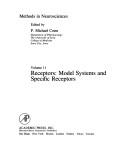
ISBN: 1483259706 0121852717 1322054614 9780121852719 0121852725 9780121852726 Publisher: San Diego London Academic.
Abstract | Keywords | Export | Availability | Bookmark
 Loading...
Loading...Choose an application
- Reference Manager
- EndNote
- RefWorks (Direct export to RefWorks)
Receptors
Cell receptors. --- Cell membrane receptors --- Cell surface receptors --- Receptors, Cell --- Binding sites (Biochemistry) --- Cell membranes --- Proteins
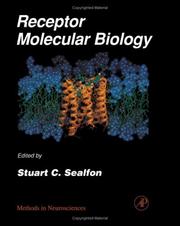
ISBN: 9780121852955 0121852954 9780080536446 0080536441 1281059269 9781281059260 9786611059262 Year: 1995 Publisher: San Diego Academic Press
Abstract | Keywords | Export | Availability | Bookmark
 Loading...
Loading...Choose an application
- Reference Manager
- EndNote
- RefWorks (Direct export to RefWorks)
The volumes in this series include contemporary techniques significant to a particular branch of neuroscience. They are an invaluable aid to the student as well as the experienced researcher not only in developing protocols in neuroscience but in disciplines where research is becoming closely related to neuroscience. Each volume of Methods in Neurosciences contains an index, and each chapter includes references. Dr. Conn became Editor-in-Chief of the series beginning with Volume 15, so each subsequent volume could be guest-edited by an expert in that specific field. This further strengt
Cell receptors. --- Ligands. --- Coordination compounds --- Cell membrane receptors --- Cell surface receptors --- Receptors, Cell --- Binding sites (Biochemistry) --- Cell membranes --- Proteins
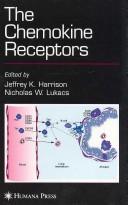
ISBN: 1280971681 9786610971688 1597450200 158829773X Year: 2007 Publisher: Totowa, N.J. : London : Humana ; Springer [distributor],
Abstract | Keywords | Export | Availability | Bookmark
 Loading...
Loading...Choose an application
- Reference Manager
- EndNote
- RefWorks (Direct export to RefWorks)
To date, there are over twenty different chemokine receptors, binding nearly fifty unique ligands that have been identified. In Chemokine Receptors, leading investigators attempt to distill the large body of literature ranging from basic molecular and cellular mechanism of chemokine receptors, to physiological and pathological roles of chemokines. Chemokines exhibit a tremendous functional diversity and participate in a wide variety of processes that include inflammation, innate and adaptive immunity, immune cell differentiation, angiogenesis, tumorigenesis, development, neurobiology and viral pathogenesis. Chemokine Receptors targets the pharmaceutical industry, provides an authoritative perspective on the future direction of this field, and insights into areas of active development of novel therapeutics.
Chemokines. --- Cell receptors. --- Cell membrane receptors --- Cell surface receptors --- Receptors, Cell --- Binding sites (Biochemistry) --- Cell membranes --- Proteins --- Chemotactic cytokines --- Inflammatory peptides --- Intercrines --- Cytokines --- Inflammation --- Peptides --- Mediators
Book
ISBN: 1617791393 1617791385 Year: 2011 Publisher: Totowa, NJ : Humana Press : Imprint: Humana,
Abstract | Keywords | Export | Availability | Bookmark
 Loading...
Loading...Choose an application
- Reference Manager
- EndNote
- RefWorks (Direct export to RefWorks)
Immunology has made significant progress in the past decade, driven forward by rapidly advancing technology and a renewed interest in the vast realm of innate immunity. The receptors that mediate these functions are at the front lines of both protective and regulative roles of the immune system. In Immune Receptors: Methods and Protocols, expert researchers present a variety of experimental approaches to the characterization of immune receptors and the cell biology that mediates their functions. These include imaging techniques that aim to understand receptor localization and trafficking, techniques to measure receptor-ligand interactions, strategies to identify novel ligands and methods to analyze downstream receptor signaling, as well as strategies for genomic and proteomic characterization of receptor repertoires. Written in the highly successful Methods in Molecular Biology™ series format, chapters include introductions to their respective subjects, lists of the necessary materials and reagents, step-by-step, readily reproducible laboratory protocols, and tips on troubleshooting and avoiding known pitfalls. Authoritative and practical, Immune Receptors: Methods and Protocols offers technical descriptions and protocols that will be useful both to investigators who are interested in carrying out these procedures and to those who seek a deeper understanding of the bench science that lies behind the immunology literature.
Immunology. --- Cell receptors. --- Receptors. --- Cell membrane receptors --- Cell surface receptors --- Receptors, Cell --- Binding sites (Biochemistry) --- Cell membranes --- Proteins --- Immunobiology --- Life sciences --- Serology
Book
ISBN: 1493991302 1493991299 Year: 2019 Publisher: New York, NY : Springer New York : Imprint: Humana,
Abstract | Keywords | Export | Availability | Bookmark
 Loading...
Loading...Choose an application
- Reference Manager
- EndNote
- RefWorks (Direct export to RefWorks)
This book covers a wide range of state-of-the-art methodologies and detailed protocols currently used to study the actions that lipid-activated nuclear receptors and their co-regulators have in tissues and immune cell types considered classic metabolic “powerhouses”. This includes the liver, adipose tissue, and monocytes/macrophages present in these and other metabolic tissues. While the main focus is on the oxysterol receptor or Liver X Receptor (LXR), the majority of the methods described can be easily applied to multiple nuclear receptors, as well as to other tissues or cell types. Written in the highly successful Methods in Molecular Biology series format, chapters include introductions to their respective topics, lists of the necessary materials and reagents, step-by-step, readily reproducible laboratory protocols, and tips on troubleshooting and avoiding known pitfalls. Authoritative and cutting-edge, Lipid-Activated Nuclear Receptors: Methods and Protocols serves as an ideal guide for researchers pursuing the vital study of nuclear receptor biology and beyond.
Cell receptors. --- Lipids. --- Receptors. --- Lipidology. --- Lipides --- Lipins --- Lipoids --- Biomolecules --- Steroids --- Cell membrane receptors --- Cell surface receptors --- Receptors, Cell --- Binding sites (Biochemistry) --- Cell membranes --- Proteins
Book
ISBN: 1789853915 1789845238 Year: 2020 Publisher: London : IntechOpen,
Abstract | Keywords | Export | Availability | Bookmark
 Loading...
Loading...Choose an application
- Reference Manager
- EndNote
- RefWorks (Direct export to RefWorks)
Cell receptors. --- Proteins. --- Proteids --- Biomolecules --- Polypeptides --- Proteomics --- Cell membrane receptors --- Cell surface receptors --- Receptors, Cell --- Binding sites (Biochemistry) --- Cell membranes --- Proteins
Book
ISBN: 1493933337 1493933353 Year: 2016 Publisher: New York, NY : Springer New York : Imprint: Humana,
Abstract | Keywords | Export | Availability | Bookmark
 Loading...
Loading...Choose an application
- Reference Manager
- EndNote
- RefWorks (Direct export to RefWorks)
This second edition volume expands on the first edition with new developments on Toll-Like Receptors (TLRs) controlling events such as cross-priming of associated pattern recognition receptors, post-transcriptional regulation, interaction with other cellular and biologic systems, and cancer progression. This book is divided into five sections: Part I outlines methods for TLR detection, interaction, and intracellular trafficking; Part II describes methods and assays to investigate how TLRs cross-prime other pattern recognition receptors, including intracellular DNA receptors and inflammasome formation; Part III highlights RNA regulation, detailing how TLRs can induce RNA transcripts and molecules such as lncRNAs and microRNAs; Part IV explores TLR detection and activation in systems such as epithelial barrier function, metabolism and the circadian clock, as well as cellular systems including T and B lymphocytes; and Part V describes models to delineate the role of TLRs in diseases such as dermatitis, arthritis, and gastric cancer. Written in the highly successful Methods in Molecular Biology series format, each chapter contains a summary, a list of required materials, step-by-step, readily reproducible laboratory protocols, useful notes to investigate TLRs in cell culture, systems and disease, and tips on troubleshooting and avoiding known pitfalls. Practical and cutting-edge, Toll-Like Receptors: Methods and Protocols, Second Edition is a valuable resource to any immunologist, molecular or medical biologist working in a laboratory setting. It will add skill to both students and the more advanced molecular biologist who wishes to learn a new technique or move to a different area within their current repertoire of practical knowledge.
Immunology. --- Cell receptors. --- Receptors. --- Cell membrane receptors --- Cell surface receptors --- Receptors, Cell --- Binding sites (Biochemistry) --- Cell membranes --- Proteins --- Immunobiology --- Life sciences --- Serology
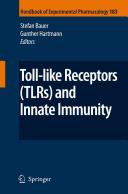
ISBN: 1281138096 9786611138097 3540721673 3540721665 Year: 2008 Volume: 183 Publisher: Berlin : Springer,
Abstract | Keywords | Export | Availability | Bookmark
 Loading...
Loading...Choose an application
- Reference Manager
- EndNote
- RefWorks (Direct export to RefWorks)
Overall recent research on TLRs has led to tremendous increase in our understanding of early steps in pathogen recognition and will presumably lead to potent TLR targeting therapeutics in the future. This book reviews and highlights our recent understanding on the function and ligands of TLRs as well as their role in autoimmunity, dendritic cell activation and target structures for therapeutic intervention.
Cell receptors. --- Natural immunity. --- Disease resistance --- Host resistance --- Innate immunity --- Innate resistance --- Native immunity --- Natural resistance --- Nonspecific immunity --- Resistance to disease --- Immunity --- Cell membrane receptors --- Cell surface receptors --- Receptors, Cell --- Binding sites (Biochemistry) --- Cell membranes --- Proteins
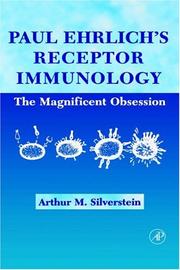
ISBN: 1281057088 9786611057084 0080538517 0126437653 9780126437652 9781435601116 1435601114 9780080538518 Year: 2002 Publisher: San Diego : Academic Press,
Abstract | Keywords | Export | Availability | Bookmark
 Loading...
Loading...Choose an application
- Reference Manager
- EndNote
- RefWorks (Direct export to RefWorks)
This book describes the background to Paul Ehrlich's immunological works and theories and delves into the substance of his experiments in great detail. By exploring these early developments in immunology, the book lays the foundation for modern concepts, providing immunologists, biomedical researchers, and students the context for the discoveries in their field.the selectionist theory of antibody formationkinetics of primary and secondary antibody responsequantitative methods of measurement of antigens and antibodydemonstration of passive transfer of immunity from mother to
Immunologists --- Immunology --- Cell receptors --- History. --- Ehrlich, Paul, --- Cell membrane receptors --- Cell surface receptors --- Receptors, Cell --- Immunobiology --- Ehrlikh, Paʼul, --- אהרליך, פאול, --- Ehrlich, P. --- Binding sites (Biochemistry) --- Cell membranes --- Proteins --- Life sciences --- Serology --- Medical scientists
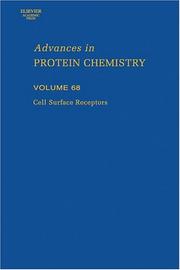
ISBN: 0120342685 9786611010713 1281010715 0080493793 9780080493794 9780120342686 Year: 2004 Publisher: Amsterdam Elsevier Academic
Abstract | Keywords | Export | Availability | Bookmark
 Loading...
Loading...Choose an application
- Reference Manager
- EndNote
- RefWorks (Direct export to RefWorks)
Cell Surface Receptors contains an extensive discussion of cell surface receptors in 11 chapters by experts in their field. As cell surface receptors are involved in almost every aspect of signaling throughout the body, the topic has been of high interest in the community in recent years.Selected Contents:-Structures of Axon Guidance Molecules and Their Neuronal Receptors-Shared Cytokine Signaling Receptor-NKG2D and Related Immunoreceptors-Inonotropic Glutamat Receptor Recognition and Activation-Chemotaxis Receptors and Signaling
Cell receptors. --- Binding sites (Biochemistry) --- Active site (Biochemistry) --- Bonding sites (Biochemistry) --- Reactive site (Biochemistry) --- Biochemistry --- Immunoglobulin idiotypes --- Immunospecificity --- Cell membrane receptors --- Cell surface receptors --- Receptors, Cell --- Cell membranes --- Proteins
| Listing 1 - 10 of 125 | << page >> |
Sort by
|

 Search
Search Feedback
Feedback About UniCat
About UniCat  Help
Help News
News